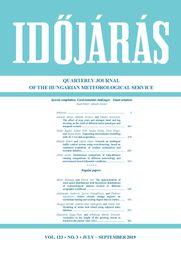IDŐJÁRÁS - angol nyelvű folyóirat
Vol. 123, No. 3 * Pages 265–408 * July - September 2019
 |
Special compilation: Environmental challenges – Smart solutions |
 letöltés [pdf: 3299 KB]
letöltés [pdf: 3299 KB]
Modeling of urban heat island using adjusted static database
Gergely Molnár, András Zénó Gyöngyösi, and Tamás Gál
DOI:10.28974/idojaras.2019.3.7 (p. 371–)
Gergely Molnár, András Zénó Gyöngyösi, and Tamás Gál
DOI:10.28974/idojaras.2019.3.7 (p. 371–)
IDŐJÁRÁS folyóirat

Az IDŐJÁRÁS a HungaroMet Nonprofit Zrt. negyedévenként megjelenő angol nyelvű folyóirata
Megrendelhető a journal.idojaras@met.hu címen.
A szerzőknek szánt útmutató itt olvasható.
Megrendelhető a journal.idojaras@met.hu címen.
A szerzőknek szánt útmutató itt olvasható.









